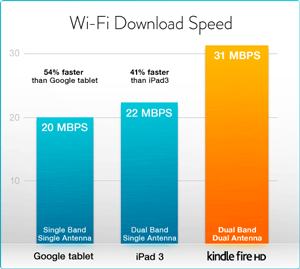Amazon's Kindle Fire HD: Better; Can It Compete With The Nexus 7?
Wi-Fi Performance: Faster From Farther Away?
Amazon knows that its customers will be using the Kindle Fire and Kindle Fire HD to stream multimedia content from its paid subscription and Instant Video (on-demand) services. So, the company claims to have prioritized wireless networking performance, which should theoretically improve the experience of anyone using the tablets the way Amazon anticipates.
Naturally, then, Amazon makes a big deal about the Kindle Fire HD's dual Wi-Fi antennas. By enabling reception/transmission over both antennas simultaneously, data throughput and quality of service should both increase at longer distances away from your wireless router.
We're happy to see Amazon minimizing the device-side bottleneck, but it's of course important to point out that most of us don't have Internet connections able to keep up with what the Kindle Fire HD is purportedly able to accommodate. Amazon's chart suggests its latest tablet is capable of 31 Mb/s. The fastest U-verse plan from AT&T, Max Turbo, has a downstream data rate between 18.1 and 24 Mb/s. Even at that speed, the difference between Google's tablet and Amazon's is almost completely masked.
| Average Throughput of 1 GB file, 10 feet From Linksys E4200 | |||
|---|---|---|---|
| Row 0 - Cell 0 | Google Nexus 7 | Amazon Kindle Fire, Second-Gen | Amazon Kindle Fire HD |
| 802.11g, 2.4 GHz | 21.7 Mb/s | 13.5 Mb/s | 16.5 Mb/s |
| 802.11n, 2.4 GHz | 22.6 Mb/s | - | 19.1 Mb/s |
We aren't quite able to replicate Amazon's numbers in our lab. Achieving 19.1 Mb/s, the Kindle Fire HD is just slightly slower than Google's Nexus 7 using 802.11n. But Amazon has certainly come a long way in improving wireless performance. After all, the second-gen Kindle Fire only manages 13.5 Mb/s on an 802.11g network.
| Distance Before Signal Drop During Transfer Test, Linksys E4200 | |||
|---|---|---|---|
| Row 0 - Cell 0 | Google Nexus 7 | Amazon Kindle Fire, Second-Gen | Amazon Kindle Fire HD |
| 802.11g, 2.4 GHz | 15 feet | 18 feet | 22 feet |
| 802.11n, 2.4 GHz | 15 feet | - | 22 feet |
Even if performance doesn't increase substantially due to MIMO, that's not the only variable in play here. We're also looking to see if the antenna configuration helps maintain a wireless connection farther from the access point. Again, using a Linksys E4200, we held onto each tablet and started walking away with our file transfer test in progress.
We passed our first interior wall three feet from the access point. The second wall was seven feet away. And the third wall was about 11 feet away. Before we could pass through an exterior wall, the Nexus 7 cut out. We made it an additional two feet past that final wall, 16 feet away from the access point, before the second-gen Kindle Fire spat back an error. And the Kindle Fire HD held on for four more feet.
Although we can't quite get behind Amazon's performance claims, we can say that the Kindle Fire HD outperforms any of the company's prior efforts with regard to wireless performance, and it does so from greater distances thanks to a dual-antenna configuration.
Get Tom's Hardware's best news and in-depth reviews, straight to your inbox.
Current page: Wi-Fi Performance: Faster From Farther Away?
Prev Page Battery Life And Recharge Time Next Page Kindle Fire HD: Another Tablet That Plays Into Amazon's Business